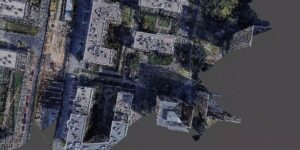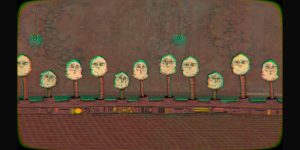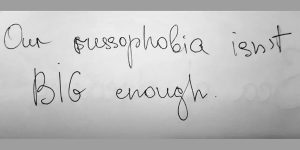surrender-reality

media-van-lab: when the wind blows from the East, we make art and (sur)render reality
Vilnius Academy of Arts (LT), MENE (LT), INSTITUTIO MEDIA (LT)
Right after the pandemic, young artists in Lithuania were hit by the war. The unrest in neighboring countries enabled them to work out how to calm down, find new ways of communication, come up with methods for resilience and survival. Let’s make art and (sur)render new virtualities to help Ukraine win. All in order to strive and continue making art. We already have Planet B more real than ever!

4408 New Messages (comment: I didn't open Telegram for a day)
Margarita Valionytė (LT)
Borders between territories change when groups of people encroach on land area, cultural heritage or national identity as property. During the conflict, state-forms lose their stability, destruction (deterritorialization) takes place in the peripheral, transitional spaces next to chaotic movement — buildings are destroyed, local flora and fauna are killed. Not only that, watching people suffer is difficult. Information, sounds and images from the horrifying areas circulating on social media. on media platforms, e.g. on Telegram, tired of the abundance of traffic, a feeling of helplessness takes over. According to Susan Sontag, the emotional response to shocking news is short-lived, so sympathy fades in comparison to actual action, leaving no change however small.

Man with a Render Animation Camera
Žilvinas Baranauskas (LT)
This audiovisual work represents a gaze towards our urban surroundings. It asks how the city is expressed in contemporary times; in what forms it surfaces from a digital and post-Soviet state of being. The city is constantly affecting us, while at the same time we are continuously generating it within digital environments.

Kodleduk
Martyna Kairaitytė (LT)
In a small, strange town lives an even smaller, round man named Kodleduk. This guy’s passion for recording and archiving the actions of the whole town has possessed the town with microphones and cameras, nothing goes unnoticed by Kodleduk. All recorded sounds and images travel to semi-organic, semi-mechanical machines of his own construction, which contain the archived spirit of the city and Kodleduk is never alone in his small apartment on the very top 22nd floor.

Please Do Not Play with Me
Eva Rodz (LT)
A doll that should decorate a man, indulge him. Even in childhood, we are already separated by wearing not just pink or blue clothes — putting on the definition of the principles of behavior, so-called masks of gender. But why are these masks made up of outdated, negative attitudes? Why does society still teach a man that he is stronger, but does not teach that a woman's body is comparable to a field of flowers? And although at the beginning I only asked you not to play with me, at the end I found the strength to admit that I am no longer your toy.

Unidentified Object
Vilija Simutytė (LT)
This piece explores the problem of cognition of the ontology of the object, inviting the viewer to encounter an unidentified object and to experience a primordial contact with it; the wonder that the Greeks already considered the main source of knowledge. Where knowledge ends and philosophy begins, a series of questions arises, possibly being the origin of new knowledge. In this work, therefore, I aim to raise questions rather than to find or provide answers. How is objective knowledge possible? The work attempts to appeal to everyone’s conception of reality by inserting into it an object that is not recognizable at first sight, thus allowing the subject to rethink their own individual scale of categories, to free themselves from the network of associations and to come closer to the Kantian “thing-in-itself.”

Vegetabilia Fractals
Ainė Petkūnaitė (LT)
In the work, fractal figures are constructed from fragments of aquatic plants, which are transformed into a synthetic simulation. After being born in the biological medium, the figures return to it. It integrates into the environment, adapts, merges with it or modifies it. And what is a biological medium? Maybe it is also generated?

Relic
Evelina Bernatonytė (LT)
From icons suddenly bursting into tears to pieces of saints’ bodies becoming commodities, relics have acquired the ability to chimerically change the identity of their subject-object identity. In the Middle Ages, the relics of the most prominent saints were perceived as worthless until the church confirmed their authenticity. The most reliable proof of the authenticity of the relic was the fact that the sacred body did not rot. The production, distribution and competition of relics between different religious communities has become like turning parts of bodies into a commercial trade in peculiar souvenirs.

Green apple J.I
Diana Nakrevič (LT)
Same shape. Same action. Less noise.

Russophobia
Yuliia Yeromina (UA)
Our Russophobia isn’t big enough. Isn’t our Russophobia big enough? Our Russophobia still isn’t big enough. Isn’t our Russophobia still big enough? Our and your Russophobia still isn’t big enough. Isn’t our and your Russophobia still big enough? Our Russophobia just isn’t big enough.

